Maybe I'll just throw in a couple of Malaysian chefs.
Wednesday, May 3rd 2006
Terracotta Army
You can't leave China without having visiting the Terracotta Army, now enlisted as a world heritage site. First discovered by peasants in 1974, the site consists of 3 pits and an exhibition hall. There is approximately 8,000 terracotta warriors and horses to be found. Excavations are still ongoing and much time, money and research are being put into developing new technologies to unearth these pottery figures.
Terracotta is literally “baked earth” which is kiln fired at relatively low temperatures. After firing each figure in the Terracotta Army was coated with a lacquer finish to improve durability. Various colors were also applied in order to create a more realistic appearance of the figures and their clothing and equipment. Some excavated materials still retain traces of this coloring; however their exposure to air quickly causes the finish to chip or flake off. (Wikipedia)


Emperor Qin Shi Huangdi; Main building


Diagrams of the emperor's chariots
Army in Pit 1
The main pit - consists of over 6,000 warriors, in battle formation


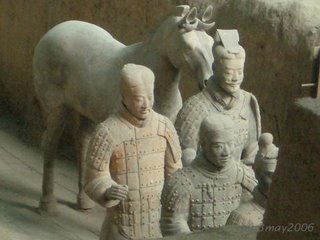
The expression on each of these 6,000 (or 8,000 in total) warriors are different from one another. You will not find two that are alike.


The photo on the right shows a section of the army that's being restored. I like to call it the "mix and match" section
Pit 2 and Pit 3
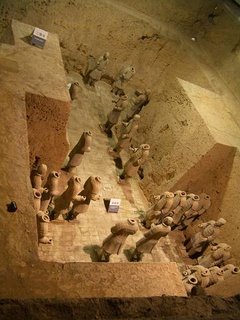



Kneeling Archer and a General
This kneeling archer is an example of the intricacies of the hand crafted figures. Check out the sole of his shoes. You can even see strands of hair being crafted onto each figure's head. From the details of each individual hair style, clothing, footwear, body shape, you will be able to determine the rank/position of the warrriors. (it is said that Generals have portruded bellies so the figures of Generals will most likely have bigger bellies)




Pictures of the terracotta army when they were first discovered


Qin Shi Huangdi's Tomb
The Terracotta Army is just one part, the defending army, of a complex necropolis. A mile west of the pits, a large hill, yet to be fully excavated, is believed to be the burial mound of emperor Qin Shi Huangdi, a tyrant preoccupied with death and the legacy he woud leave behind. He spared no expense, enlisting 700,000 people over 36 years in the tomb's consruction. Historical sources portray a miniature plan of his empire: a floor cut by rivers of mercury beneath a ceiling studded with pearls to represent the night sky. The complex is also said to contain 48 tombs for concubines who were buried alive with the emperor, a date also reserved for workers, to prevent the location and design of the tomb from becoming known.
(DK guide)



Cultural performances; information on the underground palace, etc.


Are you beginning to follow the trend? Notice the orange/yellow stuff at the very back of the photo? that was where we started the hike from; and when we got to the very top, I was disappointed to see that apart from the view of Xi'an (I swear I have seen the view of Xi'an from every mountain/hill there is here) there were only more info boards, snack stands and a dress-like-an-emperor/empress photo shack. Also, food and drinks cost twice as much up here than they do at the bottom. I guess someone's got to pay for that hike.
Anyone for pig's ears?
After that lovely hike, it was time for lunch. But first, we stopped at this outlet meant for tourists. I guess our tour guide gets a small commission for every tourist she brings in there, whether or not they bought anything. It was like walking into Costco, except the food products here are um...pretty exciting.

Pigs ears
Huaqing Hot Springs
After lunch, we popped by at the Huaqing Hot Springs. Remember Yang Kwei Fei or Yang Guefei as some spell it? Our beloved concubine whose plump figure became the classic figure of all Tang women? Well, the Huaqing Hot Springs is the love nest of Yang Guefei and Emperor Xuanzong. Don't laugh - but we actually came here to see the bathing pools of Yang Guefei. Of course those weren't the only highlights. Huaqing Hot Springs is surrounded by wonderful landscapes. Also, many visitors come here to enjoy a bath in the hot springs.
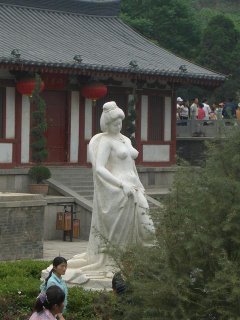
Yang Guefei sculpture




Yang Guefei's bathing pool


A bigger one for when the Emperor joins in the fun


This one's for officials of higher ranks; the little holes you see on the right were supposedly used for massaging one's feet
The Huaqing Hot Springs is located at the foot of Lishan Mountain (the name means "black horse" because its shape resembles one). So after 45 minutes of walking on flat land, we did what was expected of us again. Climb.
Lishan Mountain
We took a 5 minute cable car ride to the path where we would start hiking this mountain.
I will be honest and say that I did not reach the top. After half an hour of hiking, Ren and I decided that we have seen enough Xi'an views for the day, and that it would smarter to reserve our energy for tomorrow. So off went Wang Wei and Lanna.



Putting a tree trunk into good use
While we were resting at one of the view points, we noticed ant-size people hanging on wires gliding from one point of the mountain to another. Pretty scary if you asked me. On our way down, crazy Wang Wei decided to give it a shot. I think it was the look of the mechanism that scared me more than anything else. It looked as if it could snap in half at any given moment. But Wang Wei went and got a kick out of it.




Next.
Tang Paradise
My second favourite place throughout the trip.
If I ever had a choice as to which dynasty I'd like to live in, it would be the Tang Dynasty. Aside from the architectural splendours (simplicity is always better. The vibrant colours of the architectural structures in the other dynasties are brilliant and amazing to look at, but it would honestly drive me up the wall having to live in a colour wheel my whole life), the Tang Dynasty was considered the peak of Chinese civilization, rich in creativity of sorts - arts, literature, commerce - which stemmed from contacts with India, Japan, the Middle East, etc. AND, the one and only female king in China ruled during this era.
Ren told us we were going to Furong Park to see a cultural show at 7pm after we left Lishan Mountain. Little did I know that this Park is not just any ordinary park. It is the Tang Dynasty Reconstruction Project which only opened in April 2005. It's not even listed on the DK Guide - SHAME!
So here are excerpts from its brochure:
Tang Dynasty Reconstruction Project is one of the largest tourist programs in the northwest of China. It covers an area of 1,000 mu (about 165 acres) and is established with an investment of 1.3 billion Yuan.
...Tang Paradise is the first theme park fully demonstrating the charm and grandeur of the royal garden in Tang Dynasty.
...attractions include Elegant Lady Area, Imperial Banquet Hall, Tang Paradise Hotel, Phoenix Theatre, Tang Marketplace, Floating-drink at Qujiang Lake...
...Tang Paradise boasts many new records - the largest show on water screen in the world, the first theme park of five senses, biggest outdoor fragrance project in the world and the biggest reproduction of the Tang royal garden complex in China
Tip: If you don't get the hint yet, this is a MUST SEE attraction in Xi'an. Reserve at least half the day; also get tickets for the cultural show - it's pretty cool. There are also shuttles and camel cart rides if you're too tired to walk the grounds of the park.
Royal Garden Gate, Imperial Banquet Hall, Silver Bridge Waterfall




Royal Garden Gate - the entrance to the park; the glass screens depict women walking in circles, hoping to be picked by the Emperor as concubines; Imperial Banquet Hall; Silver Bridge Waterfall
Tang Marketplace
This is a microcosm of East Market and West Market of Chang'an in the Tang Dynasty that presents the bustling commercial activities between Chinese and foreign traders. People can observe and experience the social life in the style of the Tang Dynasty here.
What better way to experience the streets of Tang Dynasty? There are lots of arts and crafts stores, candy stalls, and also a staging area for performances.





Views of the marketplace; the two men are both selling handmade candy (as Ren says, "Just see, don't eat") - the first one is making figurines out of colourful dough (it was weird to see a tellytubby one) and the second is using a caramel like liquid to make animal shaped candies; guess your weight game
Ziyun Ruyi Tower and The Phoenix Theatre
Ziyun Ruyi Tower houses sculptures, murals and paintings reflecting the prosperous time in the Zhanguan period. There is a showroom on the top floor where you can have tea while watching singing and dancing performances of the Tang Dynasty.
The Phoenix Theatre was where we watched the cultural show. Apparently, entertainment was very popular in this dynasty. There were many large scale productions and theatres built during this era and rumour has it that one of the kings even performed in an opera himself.




Ziyun Ruyi Tower (1 & 2); that's a world map created on the grounds of the Tower - this particular section reads "Malaysia"; The Phoenix Theatre
Cultural show "Dream Back to the Great Tang Dynasty"
Yes, I did. I took three photos during the show. In normal circumstances I would've said that I'm a bad theatre audience. In fact, I shouldn't even be allowed to be in the profession. But like I said, rules simply do not apply in China (at times). I was probably the only one who did not use a flash.
It was like having a strobe light in the audience. People next to me, in front of me, behind me, above, below, whatever, were using flash photography. And then I remembered not hearing any announcements on photography, so either they forgot or they just didn't realize they could make one.
I would like to add that this show is most impressive. The set, lighting and costumes are first rate. It would be interesting to know the budget of this hour long production. There wasn't a live orchestra but the sound system was acceptable. I hate to say this, but even if this production cost under half a million, then it has definitely put M! The Opera to shame in terms of production design.
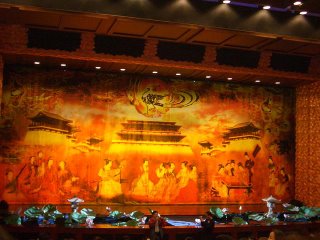



ps: the theatre loos are 3 1/2 stars by my standards, which is considered good
Imperial Banquet Hall

We headed out at around 8:30pm. I have never, ever, experienced a mad dash out of any place like I did here. Am still not sure what the rush was all about. All I remembered was being crushed and squashed at the exit gates.
Off to dinner and back to the smelly water at the hotel.
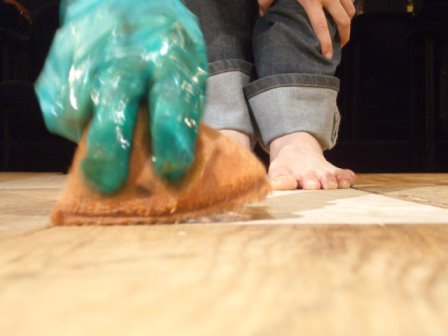
4 comments:
When are you starting your "Melt" travel guides? Seriously, this is great!
Damaso, I'm glad you're enjoying this. At least someone is. hah. Well, I need to figure out a sponsor for my travels before "Melt" travel guides happens. Any leads? ;)
Am most embarassed to say that I did not lose even an ounce during the trip (shocking and depressing). And I will explain why in my last China blog entry!
After some extensive research on the lives of Chinese Emperors, I find it hard to believe that the terracotta soldiers could be linked to anything like an artists movement. It's simply the narcissistic nature of the imperial families of the time.
If you come to Malaysia, there will not be as much walking, unless of course you want to climb Mt. Kinabalu. Next year perhaps?
Post a Comment